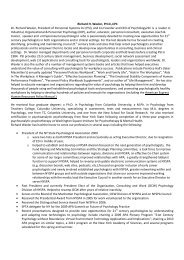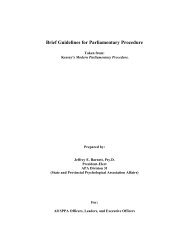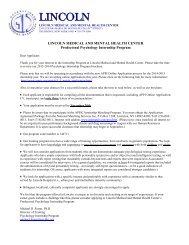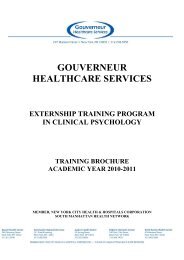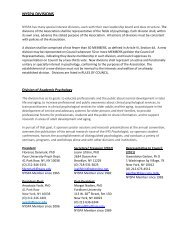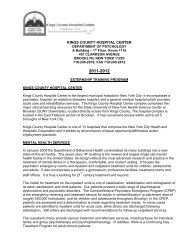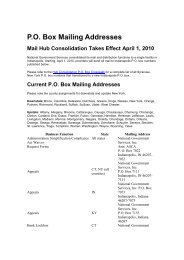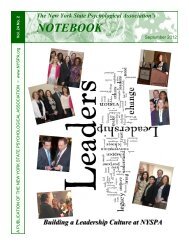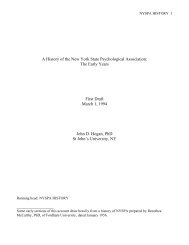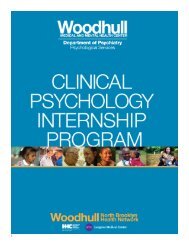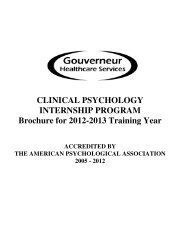2011 ⢠NYS Psychologist - New York State Psychological Association
2011 ⢠NYS Psychologist - New York State Psychological Association
2011 ⢠NYS Psychologist - New York State Psychological Association
You also want an ePaper? Increase the reach of your titles
YUMPU automatically turns print PDFs into web optimized ePapers that Google loves.
– unless the judges had taken steps to learn about domestic violence<br />
or were women, when they had the lowest estimations.<br />
Custody evaluators and judges were least likely to believe that<br />
fathers make false allegations of domestic violence. Belief in false<br />
allegations of domestic violence was strongly related to beliefs<br />
that domestic violence is not important in custody and visitation<br />
decisions, that mothers alienate children from fathers, and that<br />
reluctance of victims to co-parent harms children. Acquisition of<br />
knowledge about domestic violence (attending lectures or workshops,<br />
reading books and articles, reviewing websites, etc.) was<br />
associated with support of victims. In particular, knowledge of<br />
danger assessment resulted in more frequent recommendations<br />
of sole custody for victims. Acquisition of knowledge about children’s<br />
exposure to domestic violence was associated with more<br />
frequent recommendations for supervised visitation.<br />
Implications of the study are that custody evaluators most need to<br />
learn about post-separation violence and assessing dangerousness.<br />
They also need to understand the problems that can arise<br />
from granting joint legal custody to abusers even when the victim<br />
has sole physical custody. Finally, the authors conclude that evaluators<br />
need to understand the limits of psychological testing to<br />
assess for domestic violence and to assess mental health of victims.<br />
The third study reviewed custody evaluations in a sample of<br />
69 custody cases heard in <strong>New</strong> <strong>York</strong> City Family and Supreme<br />
Courts (O’Sullivan, 2010). The primary outcome variables in this<br />
study were the safety of the parenting plan for the mother and<br />
child in (1) the evaluators’ recommendation and (2) the court outcome<br />
(either by a decision of the court following trial or by settlement<br />
agreement between the parents). Parenting plan safety was<br />
a composite of a number of variables with a range from unsafe to<br />
most safe, such as frequent or infrequent transfer of the children<br />
between the parents, unsupervised versus third party transfer,<br />
and unsupervised overnight visits versus visits at a supervised<br />
visitation center.<br />
The evaluators’ recommendations were followed in both settlements<br />
and court decisions, with no significant difference between<br />
the evaluators’ recommended plans and the plans in settlements<br />
and court orders in overall safety. The strongest influence<br />
on the evaluators’ recommendations, and therefore on the outcome<br />
of the case, was the evaluator’s familiarity with empirically<br />
established risk factors for ongoing abuse and potential lethality.<br />
The evaluator’s general knowledge of domestic violence and use<br />
of a power and control model also significantly predicted the safety<br />
of the parenting plan. Surprisingly, the severity of the abuse<br />
and the thoroughness of the evaluator’s investigation (e.g., conducting<br />
collateral interviews or reviewing criminal records) had no<br />
relationship to the safety of the parenting plan.<br />
The study showed that what the evaluator brings to the case<br />
has more influence on the family’s fate than the facts of the case.<br />
There was little consistency across evaluators; therefore, it is logically<br />
impossible that the best interests of the child are being<br />
served in all cases. In particular, the evaluator’s knowledge of<br />
ongoing risks to the mother and children was most likely to determine<br />
custody and visitation outcomes. The researchers recommend<br />
that evaluators be screened for knowledge of domestic violence<br />
and that training of custody evaluators be required.<br />
Lack of Available Training<br />
The lack of training in domestic violence among custody evaluators<br />
could be expected given the absence of required courses<br />
on this topic in graduate programs and the dearth of such courses<br />
in curricula (APA, 1996, p. 13; Pope & Feldman-Summers, 1992;<br />
Zorza, 1996). Bow and Boxer (2003) found that almost 70% of<br />
their survey respondents had taken no graduate courses covering<br />
domestic violence. A mental health professional seeking training<br />
in domestic violence would find few opportunities in <strong>New</strong> <strong>York</strong>.<br />
The Appellate Divisions occasionally offer programs in domestic<br />
violence to the mental health professionals on the panel. The<br />
Forensic Division of the <strong>New</strong> <strong>York</strong> <strong>State</strong> <strong>Psychological</strong> <strong>Association</strong><br />
is attempting to contribute to the education of psychologists<br />
about domestic violence, and offered programs on custody evaluations<br />
in cases involving domestic violence in 2007 and 2010.<br />
For someone who wishes to become truly knowledgeable in this<br />
field, those programs can be only an introduction. Saunders<br />
(2010) found, however, that professional consultations and reading<br />
books and websites about domestic violence also had a<br />
measurably positive effect on custody evaluators’ hypothetical<br />
recommendations. Viewing films and videos did not.<br />
Conclusion<br />
Allegations of domestic violence are likely to be a component<br />
of about half the cases for which courts order custody evaluations.<br />
Consequently, it is incumbent on custody evaluators to learn<br />
about domestic violence and its effects on victims and children. If<br />
evaluation of California’s required training finds that participants<br />
benefitted, <strong>New</strong> <strong>York</strong> should adopt such requirements. Meanwhile,<br />
<strong>New</strong> <strong>York</strong> custody evaluators must take the initiative to<br />
seek opportunities for learning about domestic violence. Otherwise,<br />
the courts will continue to fail often in their mandate to make<br />
custody and visitation orders that are in the “best interests of the<br />
child.” The children of <strong>New</strong> <strong>York</strong> <strong>State</strong> deserve better – they deserve<br />
the best we can give them.<br />
REFERENCES:<br />
Ackerman, M. J., & Pritzl, T. B. (<strong>2011</strong>). Child custody evaluation practices:<br />
A 20-year follow up. Family Court Review, 29, 618-628.<br />
American <strong>Psychological</strong> <strong>Association</strong>. (1996). Violence and the family:<br />
Report of the American <strong>Psychological</strong> <strong>Association</strong> Presidential Task<br />
Force on Violence and the Family. Washington, DC: Author.<br />
Baerger, D., Galatzer-Levy, R., Gould, J., & Nye, S. (2002). A methodology<br />
for reviewing the reliability and relevance of child custody evaluations.<br />
Journal of the American Academy of Matrimonial Lawyers, 18,<br />
35-73.<br />
Bow, J. & Boxer, P. (2003). Assessing allegations of domestic violence in<br />
child custody evaluations. Journal of Interpersonal Violence, 18(12),<br />
1394-1410.<br />
Brandt, L., & Ferrin, E. (2009). Charts [of family law in the fifty states].<br />
Family Law Quarterly 42(4), 757-765.<br />
Report of the Matrimonial Commission to the Chief Judge of <strong>New</strong> <strong>York</strong><br />
<strong>State</strong> (2006). Accessed 2/26/2010 from http://www.nycourts.gov/<br />
reports/matrimonialcommissionreport.pdf<br />
Craig, R. (2010). Use of the Millon Clinical Multiaxial Inventory in the psychological<br />
assessment of domestic violence: A review. Aggression &<br />
Violent Behavior, 8, 235-240.<br />
Dallam, S. & Silberg, J. (2006). Myths that place children at risk during<br />
custody disputes. Sexual Assault Report, 9(3), 33-34 & 42-47.<br />
Daubert v. Merrell Dow Pharmaceuticals, 509 U.S. 579 (1993).<br />
Davis, M. S., O’Sullivan, C. S., Susser, K., & Fields, M. D. (<strong>2011</strong>). Custody<br />
Evaluations When There Are Allegations of Domestic Violence:<br />
Practices, Beliefs, and Recommendations of Professional Evaluators.<br />
http://www.ncjrs.gov/pdffiles1/nij/grants/234465.pdf.<br />
Emery, R., Otto, R., & O’Donohue, W. (2005). A critical assessment of<br />
child custody evaluations: Limited science and a flawed system. <strong>Psychological</strong><br />
Science in the Public Interest, 6, 1-29.<br />
Erickson, N. (2005). Use of the MMPI-2 in custody evaluations involving<br />
domestic violence. Family Law Quarterly, 39, 87-108.<br />
Hardesty, J. L. (2010). The Effect of Domestic Violence Allegations on<br />
Child Custody Evaluators’ Recommendations. National Coalition<br />
Against Domestic Violence Annual Conference, August 2, Anaheim,<br />
CA.<br />
Page 11<br />
Vol. XXIII No. 2 • Fall <strong>2011</strong> • <strong>NYS</strong> <strong>Psychologist</strong>



